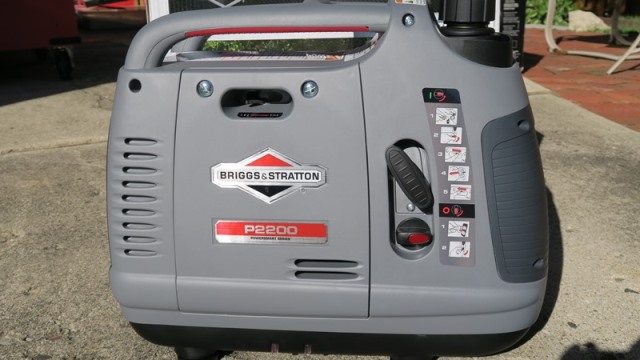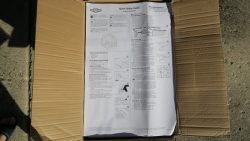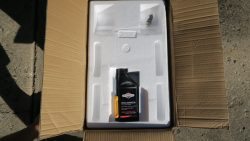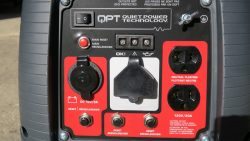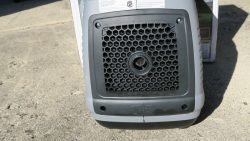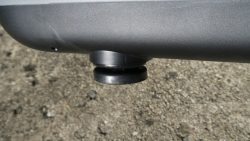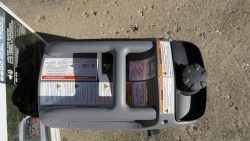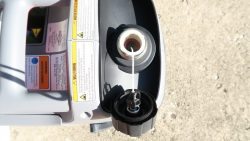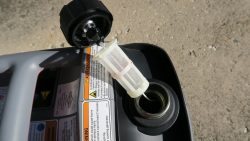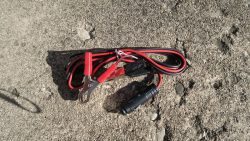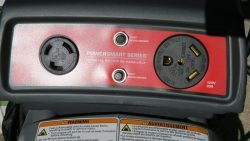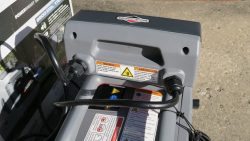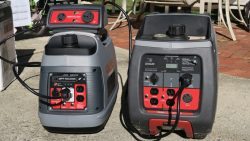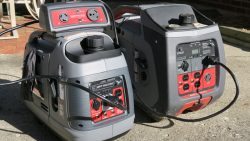Briggs & Stratton, that’s a name everyone knows. They are one of the leaders in the small engine category. Before 2014, I hadn’t had any experience with their engines. I was a Honda guy. Then in 2014 we had a chance to review the Briggs & Stratton P3000 inverter and I have to say that I was impressed. The unit was powerful, quiet and always started. Over the last couple of years, I have used the heck out of the P3000 and it runs just as good today as when I first took it out of the box. Now I have to admit, while I love the P3000, I always had my heart set on a Honda EU2000i. The P3000 was great for around the house and outdoors, but I wanted something that was lighter, smaller and perfect for tent camping or tailgating. No BS, after having the Briggs & Stratton P2200, I couldn’t care less about the Honda. The P2200 is an awesome inverter and this thing rocks.
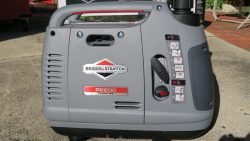 The Briggs & Stratton P2200 is designed for the campers, tailgaters or anyone who is into outdoor recreation. As you can guess by the model number, this is a 2200 starting watt inverter with 1,700 running watts. In case you are not familiar with the difference between a generator and inverter, there is a big difference. Without getting into all the technical differences, the main difference is power. With an inverter, you get clean power which means you can run sensitive electronics such as charging your phone, working off your laptop and more. So let’s take a quick walk around the inverter.
The Briggs & Stratton P2200 is designed for the campers, tailgaters or anyone who is into outdoor recreation. As you can guess by the model number, this is a 2200 starting watt inverter with 1,700 running watts. In case you are not familiar with the difference between a generator and inverter, there is a big difference. Without getting into all the technical differences, the main difference is power. With an inverter, you get clean power which means you can run sensitive electronics such as charging your phone, working off your laptop and more. So let’s take a quick walk around the inverter.
Starting on the bottom of the unit, there are four feet that hold the unit about an inch off the ground. The big deal about these feet is that they are rubberized which means two things. First, the unit will not wobble away or vibrate away. Second, it keeps the noise level down. You don’t have to worry about what surface you have the unit on, it will stop and damper noise.
On the top of the unit, there is an “H” handle which is great for when you have to move it from place to place or take it out of your trunk. You can also fill up the unit using a large mouth gas opening. One nice feature is there is a cleanable screen to help stop debris from getting into the 1 gallon gas tank. There is also a small door you can open and access the spark plug making it easy to perform routine maintenance on the unit.
One side of the unit doesn’t have anything on it that we need to concern ourselves with, while the other side has the choke, pull cord, on/off switch and easy to follow directions. You will also notice a panel for accessing the inside of the unit for maintenance. On the back of the unit is where the exhaust is located.
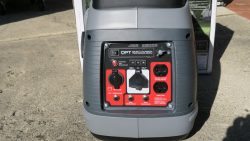 Now let’s talk about the front of the unit because this is where all the magic happens. You will notice it has 2-120V-20A outlets and one 12V-5A dc plug. There is also a small switch to turn on/off the QPT or quiet power technology. There is also a couple push button resets and a LED light display for low oil or maintenance.
Now let’s talk about the front of the unit because this is where all the magic happens. You will notice it has 2-120V-20A outlets and one 12V-5A dc plug. There is also a small switch to turn on/off the QPT or quiet power technology. There is also a couple push button resets and a LED light display for low oil or maintenance.
So now that you know your way around the unit, let’s get down and dirty and talk a little bit about the unit. When I first started it up, I couldn’t believe how quiet the unit ran. I was amazed at the noise level. In fact, this unit only runs at 59 decibels, which means flushing your toilet is louder than the Briggs & Stratton P2200. Pretty amazing isn’t it? In regards to weight, I think it is pretty light weighing in at 56 lbs. Now I am not sure how that is compared to other inverters, but compared to generators, that is much lighter. In regards to run time, Briggs hit that one out of the park also. Sorry about the baseball analogy, but with the Cubs winning the World Series that is all I can think of right now. Briggs & Stratton P2200 uses a 1 gallon tank and will run for 8 hours at a 25% load.
Okay get this, remember when I said I used to want a Honda? The Briggs retails for about $649 compared to the Honda that is $999. So in my opinion, you get a much better inverter for 30% cheaper. Seems like a no brainier to me. I could sit here all day long and tell you how happy I am with this unit and why I love it so much, but this is just something you have to try for yourself and see. Again, they didn’t pay me to write this article, I just love this inverter that much. If you don’t believe me, check out Amazon and you can see the ratings of this unit. The ratings are high and people love it also.
Briggs & Stratton P2200 Inverter Specifications
- Running Watts 1700
- Starting Watts 2200
- Volts 120
- Running Amps 14.16
- Surge Amps 18.33
- Engine Displacement (cc) 110
- OHV Engine Yes
- Fuel Tank Capacity 1 gallon
- Run Time up to 8.0 hrs @ 25% Load
- Alternator Permanent Magnet
- Start Type Recoil
- Low Oil Shutdown Yes
- Automatic Idle Control Yes
- Muffler Super Lo-Tone™
- Fuel Gauge Yes
- Hour Meter Part of Statstation™
- Weight (lbs) 54
- Length (in) 21
- Width (in) 12.5
- Height (in) 17.35
- Consumer Warranty (Product) 2-year Limited
- Commercial Warranty (Product) 90-day
- Warranty Consumer Product Info 2-year Limited
- Warranty Commercial Product Info 90-day
Briggs & Stratton Parallel Kit
Now I know some people will either want the P2200 or the P3000. However, there will be some people who love the idea of these units but need more power. Well don’t fear, you can have the best of both worlds. Briggs & Stratton created a parallel kit that allows you to connect the P2200 to another P2200 or even the P3000. So technically speaking you can get a combined watt of 5200 watts. The kit isn’t priced bad, you can buy it online for about $99.
Bottom line the Briggs & Stratton P2200 is the inverter to own. If you need power that comes in a small size, easy to move around, quiet and just plain rocks, the Briggs & Stratton P2200 is the one to own. They are not paying me to say good things about them. This is just one of those products that I believe in and feel it’s the best option in this power range. Considering this is less than it’s competitors, it’s a must buy. If you need more power, you can jump into the P3000 or even get the parallel kit to pretty much power anything you want. If you don’t believe me, check out Amazon and you can see the ratings of this unit.

